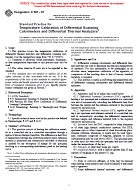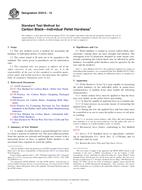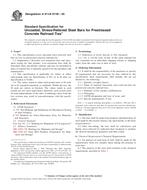1.1 This test method covers the determination of the temperature at which an arbitrary deformation occurs when specimens are subjected to an arbitrary set of testing conditions.
1.2 This test method applies to molded and sheet materials available in thicknesses of 3 mm [1/8 in.] or greater and which are rigid or semirigid at normal temperature.
Note 1
Sheet stock less than 3 mm [0.125 in.] but more than 1 mm [0.040 in.] in thickness may be tested by use of a composite sample having a minimum thickness of 3 mm. The laminae must be of uniform stress distribution. One type of composite specimen has been prepared by cementing the ends of the laminae together and then smoothing the edges with sandpaper. The direction of loading shall be perpendicular to the edges of the individual laminae.
1.3 The values stated in SI units are to be regarded as standard. The values given in brackets are for information only.
This standard does not purport to address all of the safety concerns, if any, associated with its use. It is the responsibility of the user of this standard to establish appropriate safety and health practices and determine the applicability of regulatory limitations prior to use.
Note 2
The test method described as a Method B of this test method, and test methods Ae and Be of ISO 75-1 and ISO 75-2, 1993, are technically equivalent.
1.4 This procedure covers an alternate technique for measuring the net force that is applied to a deflection temperature specimen at midspan.
1.5 The net force is measured with the specimen support unit and loading assembly in place, that is, immersed in the heat-transfer medium.
1.6 This technique permits the user to account for discrepancies in the actual load applied to the specimen as a result of spring forces, friction, buoyancy, etc.
Product Details
- Published:
- 03/15/2006
- Number of Pages:
- 13
- File Size:
- 1 file , 210 KB


